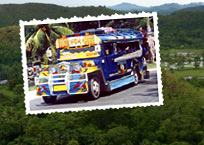Bringing electrical and electronic equipment to the Philippines
IJsselstein, Friday, 21 February 2003 (updated: Thursday, 17 January 2008)
When you want to bring electrical or electronic equipment to the Philippines, there are a number of issues to take care of.
1. Power Compatibility
The Philippines generally uses 220 volts at 60 Hz with U.S. style flat blade attachment plugs (symmetric). In a few cases, buildings also have 110 volt wiring, mostly used for air-conditioners, of which you have to be aware.
Using equipment at the wrong voltage is a sure way of destroying them.
If you come from North-America, using 110-120 volts, 60 Hertz, your plugs will fit, but you will have to make sure that your equipment can handle the voltage, which is twice as high as at home. Some equipment (such as modern lap-tops) can automatically detect and adjust to the higher voltage, other equipment will need to be manually adjusted, often with a small switch on the back. A lot of audio equipment and televisions and most larger equipment, such as washing machines, dish-washers, etc., cannot be adjusted, and will require relatively expensive transformers (that also constantly waste some energy doing their job, and electricity is expensive in the Philippines!).
If you come from Europe, using 220-240 volts, 50 Hertz, the voltage will match, but not the plugs and the frequency. In my experience, the mismatch of frequency is not a big problem -- but it might be with equipment including electric motors, such as washing machines. Flat blade attachment plugs can be bought at any hardware shop, but some of the cheaper ones aren't exactly safe. Adapter plugs are also available, but a little more difficult to find. If you are building a new house, you could consider installing outlets that can take both types of plug. It will require some searching, but they are available.
2. Television and DVD System Compatibility
Televisions and video-recorders use the American NTSC system, so if you come from North America, you will have little trouble. Most newer equipment sold in Europe (PAL and SECAM) also have no problem handling a NTSC signal, but it is worthwhile to verify this before shipping your things. The other way round, that is, using PAL on NTSC equipment is normally not possible.
DVD-players in the Philippines are supposed to be locked to region 3, and most international DVDs sold in the Philippines are also restricted to region 3, which means that an unmodified North American (region 1) or European (region 2) player will not play them. Fortunately many players can easily be modified to accept all regions. Verify this before buying one. Philippine movies on DVD are often region free, even though the box may say differently. Unfortunately, they are often of low quality (hardly any better than VCD), and often even lack English subtitles.
Besides DVDs, which are slowly being introduced in the Philippines, you will come across Video CD (VCD) disks. This is a video standard very popular in Asia, based on standard CDs. Many DVD players can play VCDs out of the box, and many more can be modified to play them by entering a service code. This is something to verify before buying or bringing one. Almost every CD player sold in the Philippines is capable of Video CD. Note that VCD players cannot play DVDs.
3. Cellphone Compatibility
In the Philippines, GSM is used, both at 900 and 1800 MHz, so most Americans are out-of-luck. GSM phones are very popular: with a 100 million text messages a day (!), the Filipinos are the world champions in text messaging.
Coming from Europe, your GSM phone will work, and as most providers have agreements with several Philippine providers, you will be offered access a several networks. However, if you make a lot of local calls, it is considerably cheaper to get a local sim card, and use Philippine pre-paid cards A SIM card costs about 500 pesos, including 300 pesos for making calls; pre-paid cards start as low as 100 pesos. Don't forget to tell the people at home your new cell-phone number! As international calls from the Philippines are terrible expensive, you can ask people at home to call you back to significantly reduce your costs (even when you reimburse them for the cost of the call: a one-minute call from the Philippines to Holland costs about PHP 100, the same call from Holland to the Philippines about PHP 10).
4. Costs
Electronics cost about the same or less in the Philippines as they do in the US (though the recent decline of the dollar may have changed this), and are considerably cheaper than in the EU. Add to this the considerable shipping cost, and you are almost always cheaper off buying new equipment in the Philippines instead of buying new equipment at home.--The only exception is high-end equipment.
Second hand equipment, however, is often somewhat more expensive, so if you already own equipment, and your shipping costs can be limited, it might be worthwhile bringing it in.
International DVDs are priced between PHP 500-1000 (USD 10-20), and Tagalog DVDs PHP 450-700 (USD 9-14), However, many are coded for region 3, and may not play at home. Video CDs are considerably cheaper (PHP 250 or USD 5), but offer lower quality. Almost all Tagalog Video CDs and many Tagalog DVDs are without English subtitles. International DVDs normally include an English sound-track, and mostly come with Chinese, Malay, and Thai subtitles.
Music CDs cost something between PHP 500 (international titles) down to PHP 50 (for cheap local covers.) Be aware that many cheaper CDs with famous artists are actually performed by Filipino bands, and take care not to accidentally buy a (Karaoke) Video CD if you don't want one.
Avoid the street-corner stands selling illegal CDs and VCDs. They might be confiscated by the customs back at home, and are often of such dismal quality that they won't play at all, or are a pain to look at or listen to.
5. Custom Regulations
As a tourist, you can only bring in equipment for your own use, and you will have to bring it out again. Trying to sell of your camera, watches, a lap-top, etc. before you leave, is mostly not worth the trouble.
For Balikbayan (if you don't know what this is, you probably don't have it), please check out the
Jeroen Hellingman
What readers think...
| Bohol Online Store wrote: |
| Tuesday, 4 February 2020 23:43:16 PHT |
| We deliver grocery items in Bohol, Philippines. If you are an OFW, overseas worker or far from Bohol, and you want to send money to your family, instead of money you can send them groceries. Visit our website at www.boholonlinestore.com Or send us an email at storebohol@gmail.com |
| Neaj wrote: |
| Saturday, 1 June 2019 07:38:04 PHT |
| Hello, good day.. My boyfriend wanted to import iphones from europe for the purpose of having a small apple store..how much do you think is the charges for this ..thankyou for your favorable response |
| Emery c wrote: |
| Tuesday, 26 March 2019 05:33:39 PHT |
| I have 110 in my apartment /hiuse, am I allowed to bring in power tools with cords |
| Douglas Barr wrote: |
| Friday, 22 March 2019 00:17:45 PHT |
| I want to bring a singer sewing machine (value $300) as a gift . Is this permissible. I will not be bringing it home with me. Can i bring it in if i pay tax on it? |
| Douglas Barr wrote: |
| Friday, 22 March 2019 00:15:51 PHT |
| Your Comment I want to bring a Singer Sewing Machine (value $300) as a gift when I visit the Philippines in May. Is this permissible. I will not be brining it home with me. |
Read all 188 comments by readers.
Also give your comments on this article
We reserve the right to remove or edit comments posted on this website. Please read our conditions of use for details. You can use <i>italics</i>, <b>bold</b>, <p> new paragraph, <a href="url">link</a>. Other markup will be removed. Use of the forums for advertising is prohibited. Enterprises located in Bohol can request to be added to the business directory.





